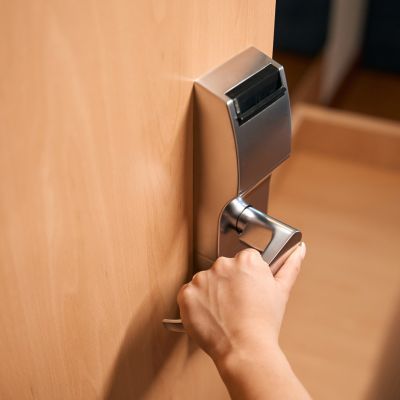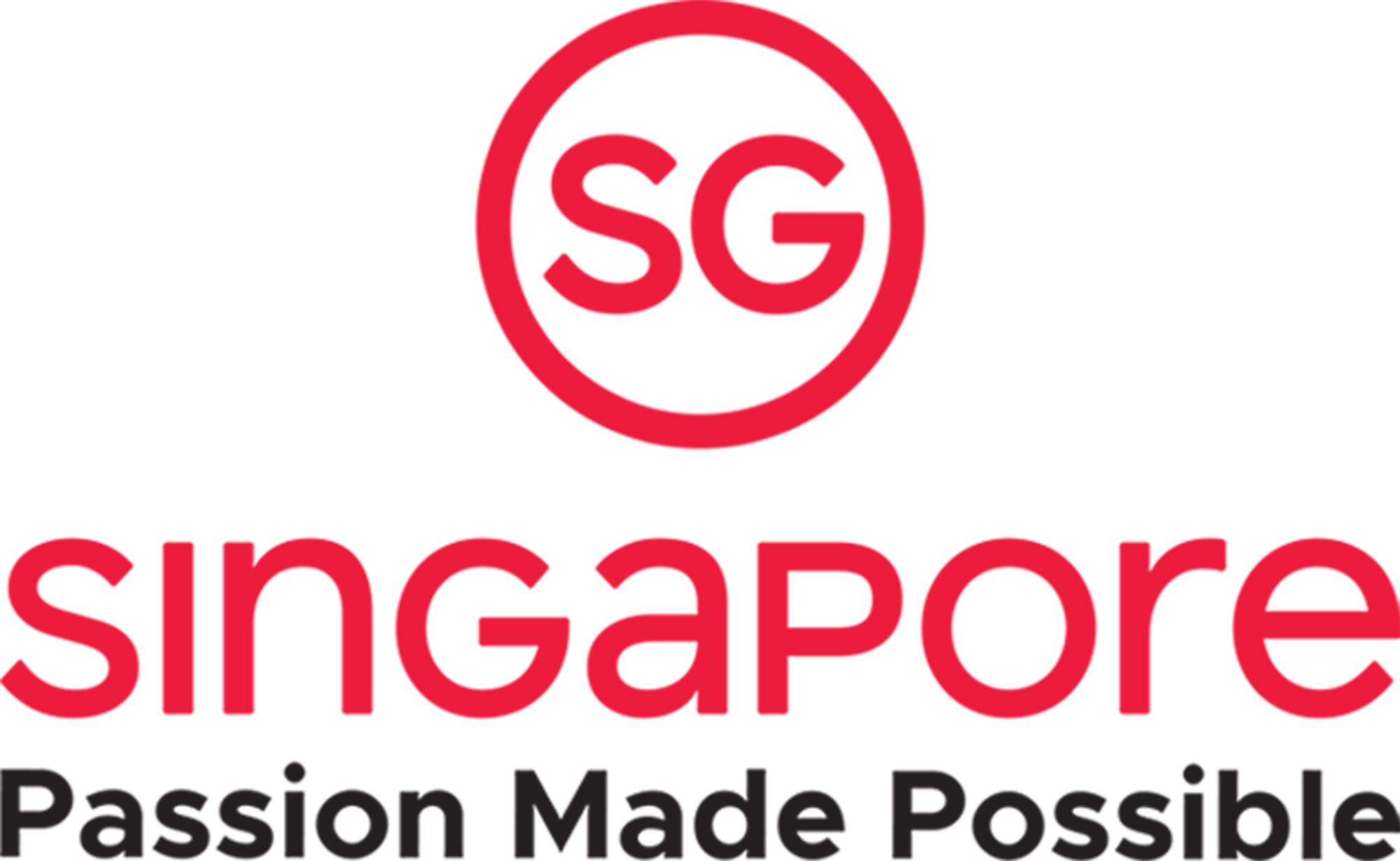For hoteliers, the occupancy rate is a constant worry.
Occupancy is primarily influenced by seasonality. The cyclical nature of peak, mid, and low seasons presents an obstacle during the transitions between these phases. The off-seasons, marked by decreased demand and underutilization of resources, can prove particularly daunting.
Typically, the first instinct is to lower rates if you want to increase room bookings. But slashing price cuts could end up costing you more. And it can lower your credibility – making guests see your property as less valuable because of prices.
A more practical option is to concentrate on offering value to your guests. Therefore, developing strategies to increase occupancy and achieve continuous guest attraction is essential.
From financial resilience to staff optimization, facility utilization, and operational efficiency, occupancy rates deliver numerous benefits for the hotel business.
But do you know how to increase hotel occupancy? To navigate this, we will discuss 17 actionable steps to keep your rooms full.
What is the Hotel Occupancy Rate?
Hotel occupancy rate is the percentage of occupied rooms in your property at a given time compared to the total number of available rooms.
A higher occupancy rate indicates effective utilization of resources and potential revenue growth, while a low rate may signal underperformance. Monitoring this metric helps hoteliers optimize pricing, marketing, and operations to maximize profitability.
Occupancy rates can give you a good idea of demand at your hotel, determine your pricing strategy, and help with revenue management. You can determine this rate in whatever way works for you — on a daily, weekly, monthly, or yearly basis.
Why is the Hotel Occupancy Rate Important?
The occupancy rate in hotels is an important KPI for hotel revenue management. The higher a hotel’s occupancy rate, the more revenue you can generate.
Tracking daily, weekly, or monthly occupancy rates will help you gain insight into valuable data. It is an instrument for forecasting demand and managing inventory and staffing levels. It also plays a crucial role in gauging marketing efforts and operational effectiveness, as a high rate suggests successful outreach, while a low rate prompts re-evaluation.
Staffing and services can be optimized during peak occupancy, enhancing guest experiences. During low season, pricing strategies can be adjusted. Aligning strategies with occupancy trends can help hoteliers boost profitability and guest satisfaction.
How to Calculate Hotel Occupancy Rates?
The hotel occupancy rate is calculated by using the number of occupied rooms by the total available rooms, then multiplying by 100 to get the percentage.
Occupancy Rate (%) = (Number of Rooms Occupied/Total Number of Available Rooms) X 100
For example, if a hotel has 150 rooms and 120 are currently occupied, the occupancy rate is 80%.
Optimal times to calculate hotel occupancy rate include:
- Daily
- Weekly
- Monthly
- Annually
- During special events
- After marketing campaign
What is a Good Occupancy Rate for Hotels?
A reasonable occupancy rate for hotels typically hovers around 70-85%.
It indicates a healthy balance between attracting guests and maximizing revenue. Occupancy rates below 70% suggest underutilized capacity, impacting profitability, while rates exceeding 80% can strain resources and potentially deter potential guests.
Several factors influence optimal rates, including hotel types, location, seasonality, and market demand. A consistent occupancy rate reflects efficient operations, superior guest journeys, marketing strategies, and a responsive approach to evolving market dynamics.
17 Strategies to Increase Hotel Occupancy
There are several strategies to increase hotel occupancy by avoiding irregular cash flow, low returns on capital investment, and underutilization of staff and facilities.
Below, we have listed strategies to help increase hotel occupancy to stimulate business when you experience low-demand periods.
1. Build Your Strategic Online Presence
We live and travel in a digital world. The hotel industry must implement effective visibility strategies to ensure their property stands out. You can strategically build an online presence by optimizing hotel websites, online booking platforms, and effective use of OTAs.
A hotel website can help you reach a wider audience, improve customer service, increase bookings, and enhance brand awareness. Some of the key reasons to have a hotel website include:
- A website simplifies the booking process.
- Client trust increases when the genuine and latest information is provided through websites.
- Websites help to show images and videos of events held at your hotel.
- A website is an efficient way to compare prices and amenities provided by hotels.
The online reservation system works all the time. It gives potential guests the freedom to book a room anytime they want. It also maximizes your sales because you are open to more than your working hours.
OTAs help you reach more customers globally and engage them while they are researching, planning, and booking their next stay. Here’s why hotels choose to use OTAs:
- OTAs give you a low-risk opportunity to grow your business.
- Greater visibility for your website.
- Increased ability to target high-value guests.
2. Implement a Dynamic Pricing Strategy
Creating a dynamic pricing strategy helps hoteliers balance base and seasonal rates. Don’t think about what the hotel room is worth; think about how much value you can deliver and generate from the guests by creating a sense of opportunity among the customers.
Consider the following steps to implement a dynamic seasonal pricing strategy:
- Define your peak seasons
- Identify additional peak seasons & hours
- Establish your base rate
- Set your seasonal rates
During peak periods, rates can be optimized to maximize revenue, capitalizing on high demand. Conversely, prices can be strategically lowered during off-peak seasons or low-demand periods to attract budget-conscious travelers.
Here’s an example of pricing for your hotel:
- Peak season: $180 per night
- Shoulder season: $160 per night
- Off-peak season: $140 per night
Effective seasonal pricing strategies help businesses adapt to seasonal demand patterns to optimize pricing and achieve long-term success.
3. Create Attractive Packages and Promotions
It’s not just about the room rate; it’s about something extra that the customers can not find anywhere else.
For example, some creative packages include spa weekends, VIP access to sporting events, and fitness classes. These packages and promotions can entice guests to stay at your hotel longer during the off-season.
Here are a handful of unique hotel packages you can offer:
- Wellness hotel packages
- Adventure hotel packages
- Event hotel packages
- Romantic hotel packages
- Wedding hotel packages
- Work from hotel packages
For example, Four Seasons Hotel Singapore offers a wide range of packages and deals for guests during the off-season.
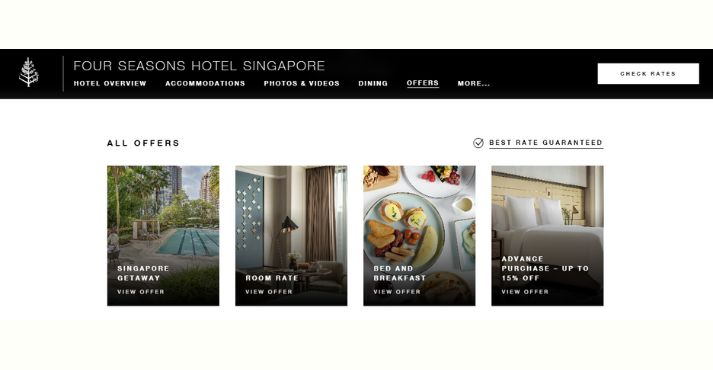
Source: Four Seasons Hotel
4. Customer Loyalty Programs
Customer loyalty refers to the commitment and attachment of a customer toward a service, product, or brand. In other words, loyal customers choose one company, location, or service over other options.
Customer loyalty programs have a significant impact on occupancy rates. It is a proven method of increasing hotel occupancy rates.
By offering exclusive perks, such as discounts, room upgrades, or complimentary amenities, hotels incentivize guests to choose their hotel repeatedly. These programs contribute to more spending and increased customer retention and engagement, mitigating the impact of off-peak seasons on hotel occupancy.
For example, the Royal Rose Hotel in Abu Dhabi offers a loyalty program that offers excellent discounts on room rates and restaurant bills and entitles guests to various benefits based on their spending.
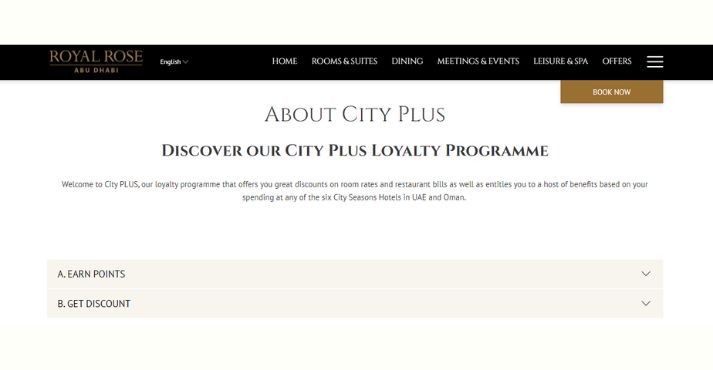
Source: Royal Rose
5. Utilize Social Media Platforms
Social media amplifies brand visibility and provides a direct channel for personalized communication, allowing hotels to build lasting relationships with their audience and ensuring a steady flow of bookings throughout the year.
During off-peak periods, hotels can leverage social media to target customers with unique campaigns, capture their attention, and engage them through vibrant posts on platforms like Facebook and Instagram.
Drive FOMO (fear of missing out) and create a sense of urgency and desire among your target customers by sharing photos, stories, and promotions highlighting unique aspects of your hotel, local events, and guest experiences.
Engage with your audience through comments, questions, and contests to build a loyal following and generate interest in your hotel.
6. Collaborate with Local Businesses
Collaborating with local businesses is a fantastic way to boost hotel occupancy rates and revenue. Start exploring business opportunities in your surrounding area and focus on getting a deal secured by promoting your hotel in exchange for the best value.
By collaborating with local restaurants, cafes, tour guides, activity providers, and other businesses, hotels can gain broader exposure to new audiences and connect with potential customers.
Here are 5 ways your hotel can collaborate with local businesses during off-peak season:
- Hosting a restaurant week or food festival featuring local eateries
- Creating a package deal that includes meals at local restaurants or shops
- Hosting cooking classes with local chefs
- Collaborating on events or activities that promote health and wellness
- Collaborating on group tours, outings, or other activities
Whatever type of collaboration you choose to pursue, remember that the key is to reach out to businesses in the area and work on mutually beneficial opportunities.
7. Offer Flexible Cancellation Policies
Guests are likelier to choose a hotel that understands and accommodates their changing plans. Cancellation policy must be crystal clear during the hotel reservation process.
Flexible cancellation policies differentiate a hotel as customer-centric, attracting a more comprehensive range of guests. It becomes a strategic tool, enhancing guest satisfaction and contributing to higher occupancy rates by reducing barriers to booking.
Cancellation policy serves two main functions:
- It ensures that guests only book a hotel room when they intend to stay.
- It helps to reduce the number of no-shows.
For example, Le Citizen Hotel Paris offers a relaxed cancellation and refund policy to allow guests to anticipate future trips confidently.
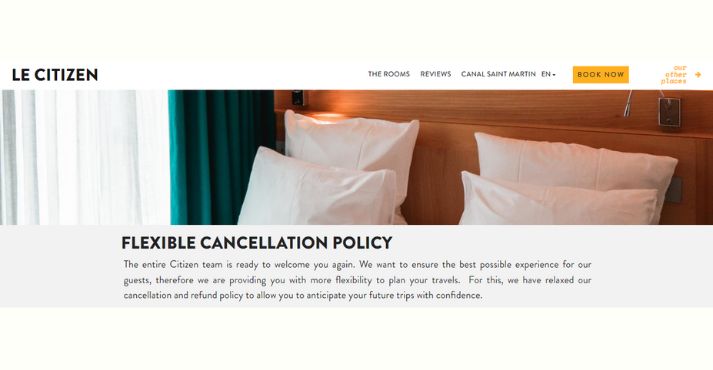
Source: Le Citizen Hotel
8. Participate in Trade Shows
As a hotelier, you should attend and participate in trade shows throughout the year. Catch your potential guest or partner’s attention at these trade shows.
Also, it is a great way to boost your booking during the off-season, as by attending trade shows, you will have access to a diverse range of people within the industry and travelers who are simply interested in booking rooms for their next trip.
Here are some of the benefits of participating in trade shows:
- Generate leads: Trade shows are a great place to meet potential customers and partners.
- Build relationships: Meet and network with other hospitality professionals.
- Brand awareness: Trade shows increase your exposure and improve your brand recognition in the industry.
- Competitive edge: Stay ahead by offering the best possible experience.
- Get inspiration: Trade shows can also be a great source of inspiration.
- Stay ahead: Learn new technologies, new ways to market your business, and improve customer service.
9. Implement Referral Programs
Referral programs are another great way to entice guests through the doors of your hotel.
A referral program refers to the rewards previous guests receive in return for recommending your hotel to their family, friends, and acquaintances.
There’s no doubt that customers trust referrals and recommendations from friends and family. It will increase customer acquisition and retention in your hotel. Hence, a hotel referral program is essential to your occupancy strategies.
For example, Marriot Bonvoy has a friend program that rewards loyal customers for bringing new guests to the hotel.
They offer their guest to earn 2,000 bonus points for each stay their referrals make, up to five stays per referral. That’s up to 50,000 bonus points. Also, it gives the referred person a 2,000 bonus for each stay, up to five stays.
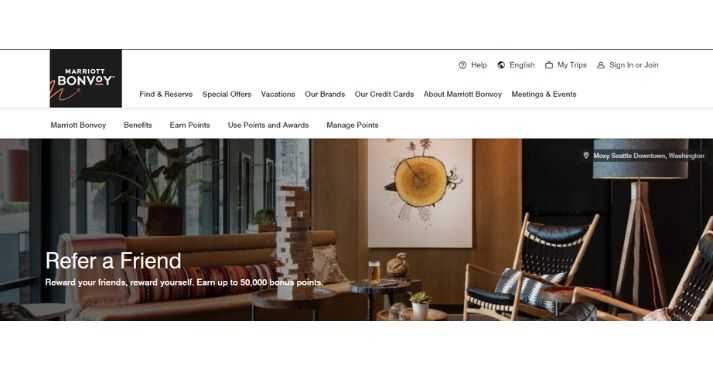
Source: Marriot Bonvoy
10. Form Partnerships with Travel Agencies
Selling rooms through travel agencies (TAs) means increasing a hotel’s occupancy rate by letting them include you in their provided services chain.
Travel agencies have established networks and a diverse client base, enabling hotels to tap into new customer segments. This collaboration enhances visibility through various distribution channels, increasing bookings and occupancy rates.
TAs charge a commission for every room booking passing through their platform. Here are some of the critical benefits of forming partnerships with TAs:
- Increase awareness and even unlock new markets
- Leverage popularity and marketing focus of TAs
- TAs help hotels to meet their audience where they are online
- Listings on OTAs provide initial awareness for potential travelers
- Hotels can capitalize on seasonal demand by simply adjusting room rates
11. Offer Contactless Check-In & Checkout
A technology that blossomed during COVID-19 has become the new normal. Contactless check-in and checkout isn’t just a trend; it’s a safer and more convenient guest experience. From the moment a guest steps into an intelligent hotel, the experience is characterized by seamless check-ins and intelligent hotel systems that eliminate the need for long queues and paperwork.
Benefits of contactless check-in and checkouts:
- Reduces staffing needs and costs
- Frees up employees to focus on the guest experience
- Creates a frictionless arrival experience
- It gives your guests more flexibility and independence
- It provides a more hygienic experience
But how can hotels implement contactless check-in and checkouts? Here are some of the key ways you can incorporate:
- Kiosks make guests more independent
- Apps give guests the most control
- Replace or update the locks at your hotel
- Reinvent your lobby and front desk area
12. Manage Your Online Reputation
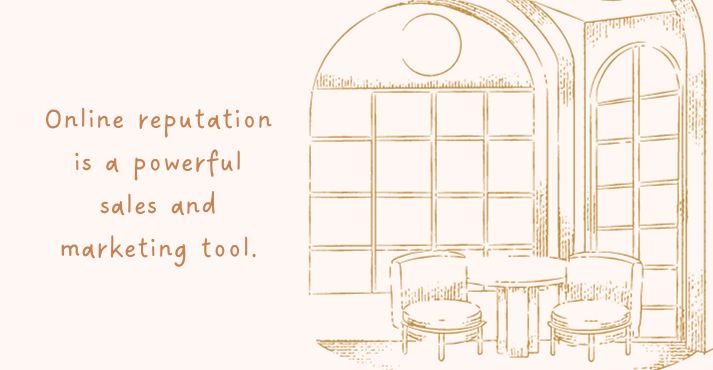
With potential guests relying heavily on online reviews and platforms to make booking decisions, managing their online reputation is essential.
But what is online reputation management? Simply put, it is the process of monitoring and improving the perception of a business on various online review sites. By managing your online reputation, you can increase your hotel’s visibility and attract more bookings.
A bad reputation will impact a hotel’s revenue, make it difficult to attract new customers, damage employee morale and retention rates, and negatively impact its brand image.
Positive reviews and mentions can generate more bookings and help build a positive reputation, leading to increased revenue.
Here are a few strategies that hotel owners and managers can put in place to maintain their online reputation:
- monitor reviews and social media channels
- respond to negative reviews in a professional and empathetic way
- encourage positive guest reviews
- creating a positive guest experience to avoid negative reviews
You can take actionable steps to improve your online reputation and stay ahead of the curve in the ever-changing hospitality industry.
13. Attract Business Travelers
Business travelers are an essential market segment for hotels. Attracting business travelers to your hotel can increase the occupancy rate, especially when there are few room bookings.
The global business travel spending is projected to reach around 1.8 trillion dollars by 2027. It is the right time to grab this opportunity and find ways to attract business travelers to your hotel.
As a full-service hotel, you can attract this valuable segment by providing the following benefits:
- Reliable & fast Wi-Fi
- Workstation and meeting spaces
- Hassle-free check-in
- Contactless guest experience
- Personalization
- Healthy F&B options
- Transportation
- Iron and ironing board
But does it matter if they can’t find you? Enhance your hotel visibility by boosting SEO and SERP rankings and, in turn, exposure.
Ensure your website is accurate, showcasing your hotel’s best business-friendly features. Craft compelling ads and website content to show travel buyers how your hotel meets their needs.
14. Invest in Employee Training
If your data shows that your occupancy rate is lower due to competition or seasonality demands, you must invest in employee training. Make your hotel service enjoyable and ensure your guests have a great experience. Train your staff to keep up with the ever-changing demands of your clientele.
Here are some of the ways to train your hotel staff:
- Develop specialized training programs for front-line staff.
- Implement ongoing customer service training.
- Provide sales and upselling training for reservation staff.
- Offer cross-functional training for employees to enhance versatility.
- Invest in technology training for improved efficiency.
- Conduct regular training on hospitality trends and market insights.
- Develop leadership and management training programs.
- Implement safety and security training to build guest confidence.
- Provide language and cultural sensitivity training.
- Foster teamwork and collaboration through team-building training.
Proper training can increase productivity, improve guest satisfaction through upselling, and enhance employee satisfaction, leading to higher occupancy rates, excellent retention, and increased revenue.
15. Add In-Demand Amenities
Amenities refer to the desirable or valuable features or facilities at the hotel. An amenity can include anything beyond a room, bathroom, and clean, safe surroundings.
While guests appreciate comforts, they like to get spoiled with unique touches. But what in-demand amenities can help you improve your guest experience?
Beyond the essentials of hotel amenities, here are some that you must pay attention to.
- Seamless and fast internet connectivity for work, entertainment, and communication.
- Automated systems for lighting, temperature, and other room features.
- Providing a convenient and inclusive meal option for guests.
- On-site gyms or partnerships with nearby fitness centers.
- Round-the-clock assistance for guest inquiries and needs.
- Incorporating sustainable initiatives for environmentally conscious guests.
- Meeting rooms, conference spaces, and business services for corporate travelers.
- Premium linens, pillows, and toiletries for a luxurious experience.
- Restaurants or cafes within the property for added convenience.
- Transportation options to and from the airport for guest convenience.
- Play areas, childcare services, and family-friendly amenities.
- On-site spa facilities or partnerships with local wellness providers.
- Customized experiences based on guest preferences and needs.
- Incentives and rewards for repeat guests to enhance customer loyalty.
With some planning, your guest will be satisfied, and you will have earned their trust, ensuring repeat business. Also, you can manage these amenities with a hospitality management system for seamless operations, guest experience, and revenue optimization.
16. Focus on Repeat Guests and Planners
Guests and planners who had a positive experience at your hotel in the past are more likely to become your repeat guests. They are much earlier to target than new ones.
To target them for repeat business, hoteliers can create email lists for each audience segment so you know when to reach out to that group with specific promotions.
Moreover, this audience segment can be targeted using remarketing ads, social media content, email campaigns, and exciting packages. For example, you can target them in the low season by offering exclusive discounts for repeat guests to come for a stay and planners to conduct events.
Implement targeted loyalty programs, offering exclusive perks and personalized experiences to repeat guests. Build relationships, ensuring a memorable stay or successful event, encouraging return visits and referrals.
17. Think Beyond Your Property
The diversity of your hotel’s target audience beyond its property increases occupancy rates. Develop partnerships with local businesses, tourist attractions, or event organizers to create mutually beneficial promotions.
Collaborate with online travel agencies or join exclusive travel networks to broaden visibility. Also, try to develop affiliations with corporate entities, offering specialized packages for business travelers. Expanding networks and affiliations allows a hotel to tap into new markets and cater to diverse interests, attracting a more comprehensive range of guests.
Conclusion
Hotel occupancy strategies combine marketing, exceptional guest experiences, and adaptability to industry trends. From leveraging digital marketing channels to optimizing pricing strategies and enhancing positive online reviews, each step contributes to a strategy for driving occupancy rates.
The key is not only to attract guests but also to retain them through exceptional service and personalized experiences. By embracing technology and constantly seeking ways to enhance the overall guest journey, hotels can create a positive reputation that sustains occupancy growth.
Hotels that consistently monitor market changes will be well-positioned to thrive. Increasing hotel occupancy is a continuous process that requires dedication, creativity, and a commitment to delivering outstanding value to guests.
Now that you know how to increase hotel occupancy, you can create a roadmap for success in a competitive market and during the off-season. Achieving higher occupancy rates ensures long-term success in the competitive hospitality industry.

